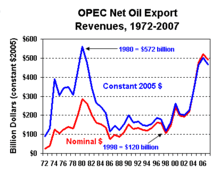Petrodollar recycling
Petrodollar recycling refers to the phenomenon of major petroleum-exporting nations – mainly the OPEC members – earning more money from the export of crude oil than they could feasibly invest in their own economies. The resulting global interdependencies and financial flows, from oil producers back to oil consumers, can reach a scale of hundreds of billions of US dollars per year across a variety of currencies, heavily influenced by government-level decisions. The phenomenon is most pronounced during periods when the price of oil is historically high.[1]
Capital flows


Especially during the years 1974–1981 and 2005–2014, oil exporters amassed large surpluses of "petrodollars" from historically expensive oil.[2][5][6] (The word has been credited alternately to Egyptian-American economist Ibrahim Oweiss and to former US Commerce Secretary Peter G. Peterson in 1973.)[7][8] These petrodollar surpluses could be defined as net US dollar-equivalents earned from the export of petroleum, in excess of the internal development needs of the exporting nations.[9] The surpluses could not be efficiently invested in their own economies, due to small populations or being at early stages of industrialization, but could be usefully invested in other nations, or spent on imports such as construction supplies, defense systems, and consumer products. Alternatively, global economic growth would have suffered if that money was withdrawn from the world economy, while the oil-exporting nations needed to be able to invest profitably to raise their long-term standard of living.[10]
While recycling petrodollars reduced the recessionary impact of the 1973 oil crisis, it caused problems especially for oil-importing countries that were paying much higher prices for oil, and incurring debts. The International Monetary Fund (IMF) estimated that the foreign debts of 100 developing countries increased by 150% between 1973 and 1977. Johan Witteveen, the Managing Director of the IMF, said in 1974: "The international monetary system is facing its most difficult period since the 1930s."[11] The IMF introduced a new lending program during 1974–1976 called the Oil Facility. Funded by oil-exporting nations and other lenders, it was available to nations suffering from acute problems with their balance of trade due to the rise in oil prices.[12]
From 1974 through 1981, the total current account surplus for all members of OPEC amounted to US$450 billion (without scaling-up for the subsequent decades of inflation). Ninety percent of this surplus was accumulated by the Arab countries of the Persian Gulf and Libya, with Iran also accumulating oil surpluses prior to the Iranian Revolution in 1979.[9]
Large volumes of Arab petrodollars were invested directly in US Treasury securities and in other financial markets of the major industrial economies,[13] often directed by government investment agencies now known as sovereign wealth funds. Many billions of petrodollars were also invested through the major commercial banks of the US and Europe. (In fact, the process contributed to the growth of the Eurodollar market as a less-regulated rival to US monetary markets.) As the recessionary condition of the world economy made investment in corporations less attractive, bankers lent the money directly to the governments of developing countries, especially in Latin America such as Brazil and Argentina[9] as well as other developing countries like Turkey. The 1973 oil crisis had created a vast dollar shortage in these countries; however, they still needed to finance their imports of oil and machinery. In early 1977, when Turkey stopped heating its prime minister's office, opposition leader Suleyman Demirel famously described the shortage as: "Turkey is in need of 70 cents."[14] As political journalist William Greider summarized the situation: "Banks collected the deposits of revenue-rich OPEC governments and lent the money to developing nations so they could avoid bankruptcy."[15] In subsequent decades, many of these developing nations found their accumulated debts to be unpayably large, concluding that it was a form of neocolonialism from which debt relief was the only escape.[16]
In the 2005–2014 petrodollar wave, financial decision-makers were able to benefit somewhat from the lessons and experiences of the previous cycle. Developing economies generally stayed better-balanced than they did in the 1970s, and global inflation and interest rates were better-contained. Oil exporters opted to make most of their investments directly into diverse global markets, and the recycling process was less dependent on intermediaries such as international banks and the IMF.[17][18] After several years of record-high OPEC revenues approaching US$1 trillion per year, most of the exporters had accumulated enough reserves to cushion the financial shock after oil prices started falling sharply in late 2014.[19]
Foreign aid
Oil-exporting countries have used part of their petrodollar surpluses to fund foreign aid programs, with Arab nations becoming some of the largest donors in the years after 1973,[9] including through the IMF and the OPEC Fund for International Development. Oil exporters have also aided poorer nations indirectly through the personal remittances sent home by tens of millions of foreign workers in the Middle East.[20]
See also
References
- ↑ Nsouli, Saleh M. (March 23, 2006). "Petrodollar Recycling and Global Imbalances". International Monetary Fund. Retrieved December 22, 2008.
- 1 2 "OPEC Revenues Fact Sheet". U.S. Energy Information Administration. January 10, 2006. Retrieved January 7, 2008.
- ↑ "Mohammed Fayed sells Harrods store to Qatar Holdings". BBC. May 8, 2010. Retrieved February 7, 2016.
- ↑ Davis, Mike (September–October 2006). "Fear and Money in Dubai". New Left Review (41). Retrieved February 12, 2016.
- ↑ "OPEC Revenues Fact Sheet". U.S. Energy Information Administration. March 31, 2015. Retrieved December 16, 2015.
- ↑ "Petrodollar Profusion". The Economist. April 28, 2012. Retrieved February 7, 2016.
- ↑ "Personality: Ibrahim M. Oweiss". Washington Report on Middle East Affairs. December 26, 1983. p. 8. Retrieved February 5, 2016.
In March 1973 [actually March 1974]... Two weeks after Dr. Oweiss had used the word – at an international monetary seminar held at Columbia University's Arden House in Harriman, New York – it was picked up by a prestigious economics commentator in The New York Times.
- ↑ Rowen, Hobart (July 9, 1973). "Peterson Urges Cooperation". Washington Post. p. A1. Retrieved February 5, 2016.
He thinks the U.S. should give more study to ways in which the excess funds – he calls them petro dollars – can be soaked up.
- 1 2 3 4 Oweiss, Ibrahim M. (1990). "Economics of Petrodollars". In Esfandiari, Haleh; Udovitch, A.L. The Economic Dimensions of Middle Eastern History. Darwin Press. pp. 179–199. Retrieved January 31, 2016.
- ↑ "Petrodollar Problem". International Monetary Fund. Retrieved January 31, 2016.
- ↑ "Recycling Petrodollars". International Monetary Fund. Retrieved January 31, 2016.
- ↑ Neu, Carl Richard (August 1977). "International Balance of Payments Financing and the Budget Process". U.S. Congressional Budget Office. pp. 27–29. Retrieved February 5, 2016.
- ↑ Spiro, David E. (1999). The Hidden Hand of American Hegemony: Petrodollar Recycling and International Markets. Ithaca: Cornell University Press. pp. 74–75. ISBN 0-8014-2884-X. Retrieved February 8, 2016.
- ↑ Özel, Işık (2014). State–Business Alliances and Economic Development: Turkey, Mexico and North Africa. Routledge. p. 34. ISBN 978-1317817826. Retrieved January 31, 2016.
- ↑ Greider, William (1987). Secrets of the Temple. Simon & Schuster. p. 340. ISBN 978-0671479893. Retrieved January 31, 2016.
- ↑ Carrasco, Enrique; McClellan, Charles; Ro, Jane (April 2007). "Foreign Debt: Forgiveness and Repudiation". The E-Book on International Finance & Development. University of Iowa. Retrieved June 8, 2011.
- ↑ Lubin, David (March 19, 2007). "Petrodollars, emerging markets and vulnerability" (PDF). Citigroup. Retrieved January 31, 2016.
- ↑ "Recycling the Petrodollars". The Economist. November 10, 2005. Retrieved February 14, 2016.
- ↑ Blas, Javier (April 13, 2015). "Oil-Rich Nations Are Selling Off Their Petrodollar Assets at Record Pace". Bloomberg News. Retrieved February 14, 2016.
- ↑ Mukherjee, Andy (February 4, 2016). "Oil's Plunge Spills Over". Bloomberg News. Retrieved February 4, 2016.
Further reading
- Clark, William R. (2005). Petrodollar Warfare. New Society Publishers. ISBN 978-0865715141.
- Smolyar, Leonid (2006). Petrodollars: Tracking the Flow and Investment of Oil Windfalls (PDF) (Thesis). New York University. Retrieved April 25, 2012.
- Staats, Elmer B. (1979). "The U.S.–Saudi Arabian Joint Commission on Economic Cooperation". U.S. Government Accountability Office. Retrieved January 31, 2016.
| ||||||||||||||||||||||||||||||||||||||
